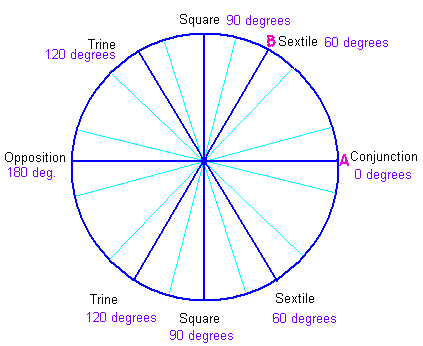Transits for Astro-Trading
What's a Transit? |
| Back to Contents |
 The maximum angle for which two planets are said to form an aspect is called an orb. Thus if the angle between two planets is 8° then they are conjunct with respect to an orb of 10°, but not with respect to an orb of 5°. Orb values are freely chosen, not determined, except that they are always more than 0° and normally never more than 15°.
The maximum angle for which two planets are said to form an aspect is called an orb. Thus if the angle between two planets is 8° then they are conjunct with respect to an orb of 10°, but not with respect to an orb of 5°. Orb values are freely chosen, not determined, except that they are always more than 0° and normally never more than 15°.
Consider two planets A and B which are initially exactly conjunct, and suppose that B moves faster than A, so that after a while B has moved 60° beyond A (anticlockwise from the '0 degrees' position in the diagram). The two planets then form an exact sextile aspect. But this sextile began earlier. Relative to an orb of 15° the sextile began when planet B first reached a position 45° beyond A, because 60°-15° = 45°. The sextile will persist until planet B reaches a position 75° beyond A, because 60°+15° = 75°. Relative to an orb of 10°, the sextile begins when B reaches a position 50° beyond A and it ends when B is 70° beyond A. Relative to an orb of 5°, the sextile begins when B reaches a position 55° beyond A and it ends when B is 65° beyond A.
Planets (other than the Sun) can move backwards along the ecliptic (this is called retrograde motion), but ignoring this for the moment, planet B will form aspects successively with planet A in the following order: conjunction, sextile, square, trine, opposition, trine, square, sextile and back to conjunction. But because both planets (other than the Sun) may exhibit retrograde motion, the succession of aspects is often not as regular as this, and it may be quite complicated.
From the point of view of an ideal observer at the center of the Sun, the Earth traces out a complete circle against the background of the fixed stars during the course of a seasonal year, and it traces out the same circle every year. This circle is the same as the circle traced out by the Sun as seen from the Earth. Thus from the point of view of the Sun the Earth and the other planets also travel along the ecliptic (in the ecliptic plane).
A heliocentric transit is exactly the same as a geocentric transit except that the angular relationship of two planets forming an aspect is determined by their position on the Sun-centered ecliptic rather than on the Earth-centered ecliptic. At any given time, the position of a planet on the Sun-centered ecliptic is slightly different from its position on the Earth-centered ecliptic due to the fact that the Earth is 93 million miles distant from the Sun.
| Next: Input to the Program | |
| Transits for Astro-Trading | Home Page |